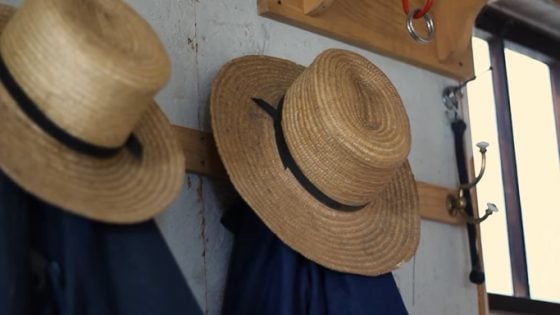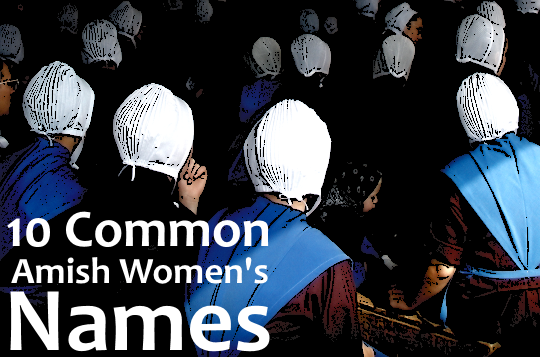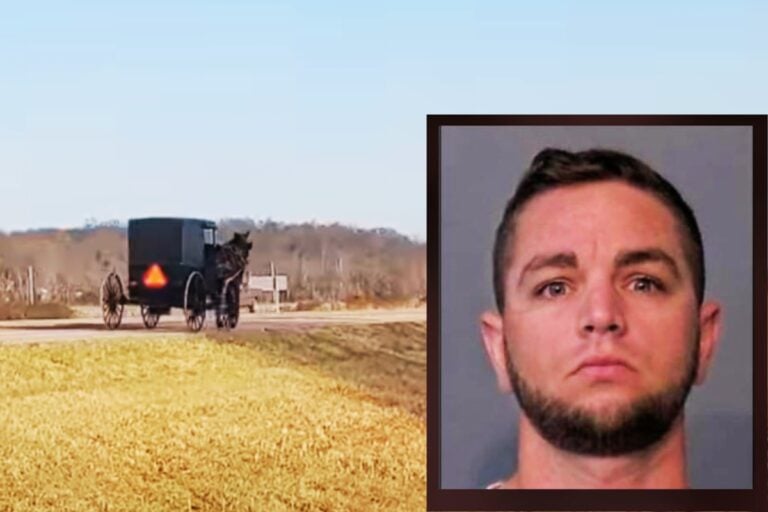The Amish Bishop, The President, And Humble Service
Do you ever meet those people who have extraordinary stories…but are the last to share those stories with the world? You know who I’m talking about. The modest folks who abhor boasting about themselves.
Today, Jim Cates writes of one Amish bishop whose humble demeanor masks a dedication to service which has greatly benefitted his own community and beyond.
When God Calls
I believe in Christianity as I believe that the sun has risen,
not only because I see it, but because by it I see everything else.
C.S. Lewis
There aren’t a lot of Amish bishops who were friends with Jimmy Carter. Of course, I didn’t learn that from this particular bishop. What I learned about his exploits would fit in a teaspoon. It was long after I had recognized him as a quiet, wise, and resourceful leader that I discovered that a former President of the United States had an affection for him too. At the time, of course, he was more than another Amish bishop to me. I just had no idea how much effort he made to quietly change the world.
His early life was humble enough. Raised on a farm in a large Amish family during the Great Depression, his primary claim to fame was a formidable skill at softball that served him in good stead through his childhood and adolescent years. Too young to face service in World War II, he was a conscientious objector during the Korean War and served in a psychiatric hospital, an alternative service that would have significant repercussions later in his life. Chosen by lot as a minister at an early age, the position of bishop in his church opened not long afterward, and the lot fell to him once again.

Unknown to his church, the man and the hour had met. Among his many children, one was rapidly demonstrating symptoms consistent with a mental illness. He was aware of the services available from his work in psychiatric wards during his time in alternative service. He studied the available literature and spoke with professionals to better understand ways in which treatments had improved. The choices were starkly clear. Services existed outside the settlement, where his child would be exposed to non-Amish influences. Within the settlement, Amish influence would hold sway, but services simply did not exist.
Slowly, patiently, he laid the foundation to allow his child to remain within Amish influence and still receive the quality of service that he knew to be available. He bided his time, spoke with others, and listened carefully for opportunities to move forward. Several who had left the Amish and worked in mental health were simultaneously working to create these same services. Still, theirs was an odd position. At once familiar with the culture – “insiders,” born and raised in that insular world – they had chosen to walk away, leaving them in a shadowland. They needed to reach out and grip the hand of someone still there, just as the bishop needed to reach out and grip their hand, as someone ensconced in the mental health services he needed to access. No one else was placed in quite the same unique position as he was, both aware of the need, and anxious to act on it.
And the outcome? Today there are multiple sites built on a model of Amish-driven services coordinating with state of the art mental health interventions. Even stand-alone Amish residential centers have begun to work with community mental health centers to facilitate more effective care. And a primary impetus for this work? You will never know his name. He lives quietly, in humble obscurity, content with the fact that he served a part in all that has happened.
I met him after his work to establish this cooperative venture had succeeded, and he was moving into a slower phase of his life. I also met him long after he had charmed Jimmy and Rosalynn Carter with his quiet grace and stolid demeanor (he had been selected for a “photo op” for the ex-Pres in an Amish home that turned into oh, so much more once they actually met). He became a mentor in my early work with the Amish, teaching me more by his mere presence than by any of his words, and demonstrating the most effective method to interview and consult with their clergy.
He is a gentle man who frets over how best to serve God. At times, he ruminates over situations that others would say cannot be solved. It is a simultaneous blessing and curse, the stubborn streak that kept him in pursuit of a dream of improved mental health services for the Amish when it seemed an impossible task. Now, older and frail of body, he still finds himself striving to improve the lot of those for whom he cares in such a deep and ministerial way, even when the task seems impossible.
I am glad to know him. Thankful to have him in my life, blessed to call him a mentor. He exemplifies both clergy and the Amish at their best. As C.S. Lewis reminds us, to be a Christian is to see everything else through that faith. This man of God still does.
Jim Cates is author of Serving the Amish: A Cultural Guide for Professionals. He can be contacted through this blog or his website at servingtheamish.net.
Farm at dusk image- Cindy Seigle







Inspiring
This is inspiring. Thank you for sharing it. God bless you both.
The Amish Bishop...
Wonderful!
The Amish Bishop
Thank you not only for the story, but for the heartwarming feeling your storytelling leaves. Lingering in our hearts, spirits, subconscious if you like, to serve as a soothing candlelight in the hour of need. Or when seeing or feeling only darkness around us. And heartfelt thanks to the Bishop for everything he had done for his people as he did it for us too. Inspiring…..
Amish clinics
I cant find the quote right now, but one of the fathers of the field of psychology cautioned that the field can be used for good or ill. Along those lines, are you aware of complications or issues from your collaboration with the Amish?
I’m aware of an Amish person who was questioning compliance with Amish practices. A side effect of his doubt was emotional turmoil. Along with his wife, he attended a plain community sponsored and run “clinic.” After being there for several days, he decided that he didn’t need to be there. Against the wishes of the support staff and his wife he left the clinic. On his way home, he stopped at a family members house to pick up their children. The family member refused to let him have his own children, going so far as calling the cops. He left without his own children.
It is my understanding that his condition was not a case of being mentally ill to the point that the children would’ve been unsafe with him, but withholding them was about bullying him into submitting to orthodox Amish practice.
I don’t know what the responding officer did, but is there a risk of care providers like yourself getting drawn into the political struggles of Amish authority? In an interview with NPR, you stated that your number one priority, in working with the Amish is to protect the community. Is there a point where your attempts to be neutral, become a form of enabling, making you complicit in internal compliance struggles, that compromise your work? Is there a risk of your work becoming the opposite of neutral by being co-opted by internal power struggles?
Amish clinics - response
Geniene – your point is well taken. Very well taken. It’s a delicate balance. Not to plug my own work here, but “Serving the Amish,” the book I wrote last year, addresses that issue in more detail than I can cover here. Suffice to say, issues of religious freedom, Amish internal politics, cultural awareness, ethics in one’s profession, and just plain old common sense all meet at the crossroads on so many decisions about how best to provide services to Plain people communities. And like so many complex issues, thinking, earnest people can study the problem diligently and arrive at very different answers about how to solve it. All that to say, sure – the Amish are not immune from my failures as a mental health professional. I wish it wasn’t true, but it is. Learning is a lifelong process. At the same time, failures sometimes occur because people in any culture are not ready to change. The core issue then becomes – what problems should/does a cultural hierarchy or the state have the right to force to change? You can see how long this reply could go, but I’ll stop and reiterate – excellent point, and one to always keep in mind. Thanks!
complicated
I think we would all agree that the Amish family member (in my earlier narrative) is free to petition his sibling to adhere to orthodox practices. But in the case of with holding his children because the father wants to explore new order practices, that is becoming heavy handed, but it is still not that big of a deal. It is the point where the outside civil authorities are solicited to weigh in on one side that this situation becomes monstrous. We don’t know how the officer responded, but it is in the response that this situation goes from a mundane family dispute to something much bigger. It is the point where outside authority is petitioned that the potential for extreme danger arises. If the officer stayed true to the values of his own society, meaning he would’ve given deference to the parent over the custody of a child, then all is still fine. That is the key, whether the intervening outside authority acted in compliance with the customs of their own society.
Based on what I see of your work, your approach is to make accommodations for the Amish. This may be a functional and humane thing to do, but it opens the door to judgment calls for which there is no oversight. If the responding officer took a position against the father seeking custody of his children, there is no way the father would’ve recognized that his rights were violated and sought legal recourse. The injustice would’ve stayed. It would’ve been a case of the state supporting one religion over another.
My interest is in these interactions where the state’s interest seem to align with the interests of Amish authorities. In Lancaster there was a incident of an elected representative to the US congress speaking at rallies called to oppose the show, “Amish in the City,” asking Amish youth not to participate. It is fine if Amish ministers ask that, but completely something else if an elected government official does it.
In the case of court mandated alcohol treatment of Amish youth, which you are familiar with, what happens when the church and state collaborate? If court mandated alcohol treatment is tailored to “protect” the Amish community, how is that not a violation of church and state? Particularly if “protect” means to not subject the Amish youth being treated, to anything that the church leaders wouldn’t approve of. The added dichotomy here is that the youth are supposedly in rumspringa, which is the time when they are “allowed” to experience the non Amish world. Yet, based on your model of treatment, it is a time when special care must be given to not subject them to non Amish ideas.
Amish authorities have a vested interest in advancing the idea that church membership is about choice. But your treatment model is an example of how it isn’t really a choice. If the Amish get a little heavy handed about membership, that’s kind of business as usual, but when you participate in that heavy handedness, that is a problem. The idea that the Amish leaders are using the state to shore up their communities fraying seams is counter to every core value the Amish profess to hold dear, and it violates non Amish values too.
The main post as well as comments are cause for much rumination. As someone who comes from a family where mental illness has been an “issue”, I can appreciate how dealing with it effectively can be a challenge even without religious “encumbrances”. I can appreciate what you’ve done (and the Bishop’s own attempts) to help and for his mentoring you. One can only hope for the best outcome. You can only LEAD a horse to water…
Alice Mary
Response to "Complicated," Part 2
Wow. You pack a huge number of issues into a brief comment. Let me parse a bit here in my reply. 1) I contract with various state agencies, sometimes long-term, sometimes for specific contracts, but I am not an agent of the state or federal government. 2) One of the primary reasons for providing alcohol and drug programs for Amish youth separate from the programs that did not segregate them in our area was the fundamental Christian approach used by many of these programs that was objectionable to the Amish. Again – these were agencies contracted with the state. So separation of church and state was an issue when we entered the fray – not something we created. 3) I believe your interpretation of “rumspringa” is overly broad and categorizes too much under one umbrella. 4) I have no awareness of the example you present beyond the facts you offer, and cannot comment on it based solely on the information you provide. That’s not a personal jibe – that’s a statement about any complex situation. 5) You draw my statement about “protecting” from a 12-minute segment on NPR. I should note I was interviewed by the reporter for over three hours, and met with her over the course of two days, putting her in touch with any number of people. She used a very few minutes of my statements in that piece. For a more comprehensive understanding of my views, “Serving the Amish” is the better source.
Neighbours
Amish are our neighbours. We are to love our neighbours as ourselves.
We share many beliefs, some we don’t. God made us this way.
Where beliefs cause injustice, well injustice is always wrong, love and compassion are always right.
Jesus Christ teaches us to help those in need, with love.
God bless those following this.
Amish clients
Collaborating with Amish leaders has become sacred dogma for service providers to the Amish. Involving leadership and not relating to their flock without leadership’s consent and approval is considered culturally sensitive. I question whether this practice isn’t actually detrimental for the Amish. First of all, an element of the separate and apart concept is that church issues aren’t supposed to be discussed with outsiders. The highlighting of leadership by outsiders is a form of engagement with church issues. The relationship between minister and laity should only be relevant for internal church issues. When that relationship becomes a prominent element in how outsiders relate to the Amish, outsiders influence church polity. Given how sacred the separate and apart status is for the Amish, the mere query about who the minister is, in my opinion, a form hegemony. It is injecting outside influence into what is specifically intended to be relationship, removed from outside influence.
I think the solution is for outsiders to function by the values of their own society. If they wouldn’t normally ask for approval for a treatment plan from a patient’s minister, then it probably isn’t a good idea to do it for an Amish patient. It’s kind of patronizing actually, to assume an Amish patient needs outside help or special treatment so they can be a good Amish person.
Amish Clients Response
In my opinion, there is a significant area of overlap in our thinking – area in which we agree. Still, I become wary when I hear emphatic ideas, such as the concept that collaborating with Amish leaders has become “sacred dogma for service providers.” We’re a diverse group, and herding us all under one tent is a difficult enterprise! That said, I would agree fully that there is a trend to involve Amish leadership and invest them in our enterprises. That is a cultural norm for service providers working with any group. For example, I live in Fort Wayne with a significant Burmese population. Services that extend to that immigrant group attempt to invest their leadership because of the clannish, understandably distrustful attitudes they hold toward those who reach out to them. So as a general approach? Yes. That said, I can’t speak for others working with the Amish, but for me? I ask the client. Some want the ministry involved, and in those cases, I involve the ministry. Others prefer that the ministry remain oblivious (or as oblivious as possible) to the services being offered. I remain quiet. And I wrote a chapter for an ethics book several years ago on an Amish client who asked me to speak, not only to his ministry, but his entire church about my work with him! Different churches, different ministries, different settlements, different people – I don’t walk in with a preconceived notion about how “best” to handle a situation. I walk in with the idea that every person deserves to be treated with dignity and respect. Accomplishing that is a balancing act when I am reaching across a cultural divide to help, but I try to remain sensitive to the situation. And I think most service providers work to remain moral and ethical in our attempts to serve others. Thanks Geniene. Your concerns need to be stated.
dissent is a crucial ingredient for a healthy society
While the Amish may be clannish and distrustful, not unlike the Burmese, a stipulation of Amish values is to keep the non Amish world at arms length. I question whether it is possible to circumvent that religiously inspired distance and be culturally sensitivity. Wouldn’t it be more respectful to honor the distance by refusing to participate in it? It is their thing. Not yours. Non Amish recognition of church hierarchy makes that hierarchy more pronounced.
There was a news article of how the police have made it part of their protocol, to get an Amish bishop when they are breaking up a underage drinking party. The article noted that the party goers got quiet and started talking in Pa. dutch when the bishop and the officer walked in together. It is no secret that, had either authority figure entered the party by themselves, they would’ve gotten a lot less respect. I think though that there is something much greater being lost here, beyond the dispersing of a party.
I think both the bishop and the officer were violating their own values by collaborating. While the party goers were suppressed at the moment, what happens once they realize that both the church and the state violated their own values in relating to them?
There are two categories which encompass the whole of psychotherapy. One is to teach the rat to stop bumping into the sharp edges of their cage. The other is to teach them to climb out of the cage. When you talk about protecting the Amish community, what you are talking about is, you have to omit half of what your profession has to offer when serving Amish patients. What is going to happen once your patients realize that? It may take several generations, but ultimately this doesn’t just effect individuals, it effects the whole of Amish society. In the name of cultural sensitivity, your omissions rob an entire culture of self determination. One might argue, as you do, that self determination isn’t an Amish thing. But that ignores their Anabaptist heritage. There is a saying about well behaved women didn’t change history. Well behaved Amish people won’t change it either.